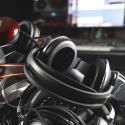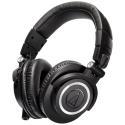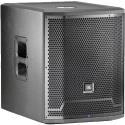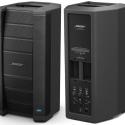What is the Ideal DJ Setup?
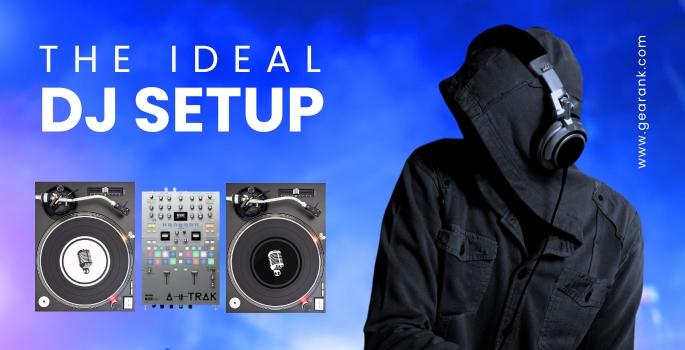
Every DJ has a weapon of choice to make the crowd dance harder. The initial step to finding the right setup can be confusing. After all, with all the different brands out there marketed as the next big thing, searching for the ideal DJ setup can be daunting.
You may be at a point where you've mastered the basics and want to optimize your flow better.
At the heart of every club, pulsating beats and lights, there stands the modern DJ. The information you need to demystify different setups is in this article. We will cover your options and what exact setup you need for other occasions.
Types of DJ Set-Ups
The setups listed below range from the simplest to the most complicated rigs you could use. Most of these setups are relatively identical in terms of functionality. However, one setup makes it more convenient than the other.
After all, if you're going to be booked for multiple gigs each night, one setup would undeniably be more advantageous than the other. You have to take into consideration the portability of your rigs.
You'll quickly realize that not all venues require you to bring full gear. It will still depend if the bars or clubs you're performing in have all the gear you need for sound projection.
Thus, just like using different knives to cook food, you need different rigs to mix in different venues!
Let's look at our options. Some of the main types of DJing setup include:
Traditional Vinyl Setup
This is the most classic among all DJ gear setups. It comprises two turntables, usually in Technics SL-1200, and a 2-channel mixer. This setup first became popular in the 1970s, when hip-hop started.
Most DJs using this setup can still be found in hip-hop communities and classic dance halls. It's a pretty old-school way of DJing. In modern music, though, you will rarely find this setup being used due to better alternatives.
Digital DJ System Setup
Digital DJ systems started around 1998-2002. Even then, DJing with vinyl records was still popular among the community. This digital setup sought to replace the traditional vinyl turntable, and helped push creative boundaries. And it came in many forms.
A popular digital setup uses 2 CDJs, a DJ mixer, and a media player. As the name implies, it initially used CDs instead of vinyl records. Nowadays, playing through songs often involves using a USB stick instead of a compact disk.
A digital DJ system also came in the form of digital vinyl records. This setup can map and manipulate the mp3 or WAV file but replicates the same feel of a traditional vinyl record.
On the MP3 or WAV side, some digital DJ rigs allow you to play CDs through a USB stick and even play music directly from streaming services.
Standalone All-In-One-System
Unlike DJ controllers, this professional DJ equipment doesn't require a laptop and will have everything a DJ needs to start. Standalone systems have built-in LCDs for quick MP3 and WAV file access.
All you have to do is plug in a USB drive or an SD card, and you can immediately browse them through its interface. Some standalone controllers, such as the Mixstream Pro Go USB-ready, allow you to stream directly from Amazon Music.
Standalone systems can be a great alternative to controller/laptop setups and mixer + 2 record decks. It's perfect for people who want to avoid fiddling around with digital devices and complicated routing setups.
DJ Controller & Software Setup
This type of setup is similar to the digital setup, but instead of media players, you have a DJ controller and a laptop with DJ software (Serato or Traktor). It grew in popularity due to convenience and affordability. It's one of the ideal DJ equipment for beginner DJs.
Among the famous ones are the Pioneer DJ controllers, such as the Pioneer DDJ-200 and the DDJ-400. However, among the many DJ controllers, such as the Numark Mixtrack Pro FX and the Native Instruments Traktor Kontrol S2 MK3 are also widely used today.
Laptop-only DJing Setup
If you remove the DJ controller from the equation, you can still perform it with a laptop. Going laptop-only is a no-nonsense starting point for those seeking to get familiar with DJing. However, getting a dedicated DJ controller for a more tactile feel would still be best.
One of the first software to showcase this feature is Virtual DJ. It involves a digital turntable and a graphical user interface with the list of mp3s saved in your hard drive.
Mobile phone/Tablet DJ system
Mobile phone DJ systems are the downsized version of a controller and software setup. The most significant upside of this rig is its portability and ease of use. This is one of the ideal setups for Beginner DJs who want to start DJing without putting a hole in their pockets.
A mobile app such as the DJ Control Mix retails at $109.99. All that's needed is downloading the Djay and Virtual DJ app on Android and the App Store. Mobile phone or tablet DJ systems give you all the essential features. It's better than a laptop-only setup.
A Closer Look at the Individual Components
We've provided a general overview of the most common DJ setups above. In standalone systems and DJ controllers with laptops, a few essential pieces like headphones would be enough. These components are primarily for people who prefer to look into individual components instead of all-in-one systems.
From DJ headphones to a separate audio interface, here are a few key components to consider when building your setup, including:
Turntables or CD Decks
The most important element of your setup is your turntables or CD decks. Turntables allow you to mix vinyl records, while a CD deck is basically a CD player that make it easy to mix digital music from CDs or MP3s. We will take a closer look at the pros and cons of each in just a moment.
Speakers/Studio Monitors
The majority of gig venues will have a sound system and monitor speakers. However, It is worth investing in your studio speakers to hear mixes while practicing at home. Bedroom DJing is best experienced if you can replicate the feel of a real club environment.
In addition, studio monitors are important for allowing DJs to listen to the mix in its purest form, making them an essential piece of DJ gear.
DJ Headphones
Aside from the mixing deck, DJ headphones are what DJs are known for. This most important accessory allows you to do beat matching, cue up, loop, and weave songs together. All without blaring it on the PA system.
It's worth mentioning that DJ headphones and studio monitors are two different types of headphones. The key difference is that DJ headphones have enhanced frequency response. Studio monitors, conversely, have a flat frequency response designed for sound engineering.
DJ Controller
We did mention that DJ controllers and laptops are among the most common setups. However, there are some key aspects that you need to know about them. DJ controllers are MIDI-based and don't make a sound by themselves. Instead, they send data in and out of the computer, allowing you to manipulate audio, effects, and other parameters. It's essential DJ equipment for beginners and professional DJs alike.
A DJ controller typically includes two decks with jog wheels for manipulating tracks and a mixer for controlling the levels between tracks. Many controllers also come with built-in effects and other features, such as volume faders, looping, and sampling, allowing DJs to move easily from one track to the next.
When considering a DJ controller, looking for compatible software is important. You also have to consider your skill level. A few DJ controllers are designed specifically for a beginner DJ, while others would require a learning curve tailored to intermediate and advanced DJs.
DJ Mixer
A DJ mixer is another essential piece of equipment if you want to buy separate DJ components. This mixer functions like a normal outboard mixer but with notable features.
Typically, DJ mixers have two channels for controlling the volume level of two tracks simultaneously - be it CDJs or turntables. Some popular ones include the Pioneer DJ DJM-250MK2 and the Pioneer DJ DJM-S5 2-channel Mixer. Remember that you have to balance or normalize audio levels when switching between tracks.
More expensive setups would have four channels, giving you more control over your mixes like the Reloop RMX-44-BT 4-channel Bluetooth DJ Mixer. Most DJ mixers I provided here are also MIDI-ready. They come with USB ports, allowing you to apply effects such as EQs, filters, and delays.
Audio Interfaces and Microphones
If you're setting up a DJ system with a DJ controller, you will need an audio interface for added flexibility. While it is possible to use your laptop's built-in output, you need extra I/Os to talk through the mic, and don't just use any mic, use the best microphones that suit your vocal style and needs. Your sound will also be better compared to when you use your built-in sound card.
When selecting audio interfaces, look for one with enough inputs and outputs to accommodate your equipment. A few of the ones I recommend are the Audient iD14 and the Focusrite Scarlett 2i2.
Laptop and Software
As mentioned, DJ controllers can't produce sound by themselves. You'll need a laptop capable enough to handle your sessions and software with all the necessary wav or mp3 and other audio digital files inside. I will list the minimum requirements below.
For PC Laptops:
-
Processor: Intel i5 (8th generation)
-
RAM: 8GB
For Macbooks:
-
Processor: M1 Chip
-
RAM: 8GB
Of course, if you plan to include 3rd party plugins, upgrading to 16GB memory is ideal. The extra bandwidth ensures that your Mac or PC will run smoothly.
Two of the industry-standard DJ software are Serato and Traktor. These software have paid and free versions like Traktor DJ 2 LE and Serato DJ Lite. Other notable ones include DJ.Studio, Mixxx, and Rekordbox Free Plan.
Turntables vs CDJs
There's always been an ongoing discussion among DJ communities about whether one should use turntables over CD decks and vice-versa.
It's undeniable that both have played a role in advancing pro DJ equipment. Turntables have been used for decades now and are still hailed as irreplaceable by old-school DJs. On the other hand, CD decks or CDJs offer entry-level options for aspiring newcomers.
Each option has its benefits and drawbacks. At the same time, there might be things that you need to consider before making a decision.
1. Turntables
Turntables have been around since the early 1930s and used since the earliest days of DJing.
Turntables are DJ equipment used to play and mix vinyl records. It involves a needle on top of the vinyl and a spinning motor rotating the disk at a set speed. A tempo fader is used to change the speed. Between two turntables is a mixer that allows the DJ to weave songs together into one cohesive track.
When using a turntable as a sound source, it is connected to the DJ mixer via RCA input.
Advantages of Turntables
The enduring popularity of turntables comes from the many advantages these pieces of equipment offer. Some of the main pros of opting for a turntable include:
Authentic Sound
Most of the sound effects known today, like spinbacks, vinyl stops, and even the warm, lo-fi feel, are due to the turntable and vinyl itself. Many DJs still hail this analog aspect of classic turntables as unmatched.
There's also an element of nostalgia surrounding the sound of vinyl records. The pre-digital era of DJing brings about an element of authenticity that is sometimes not present in modern-day, processed DJing.
Tactile feel
If you want to feel the vinyl record grazing your fingertips, then a turntable will be a great choice for scratching and spinbacks.
Great for learning the basics
It can be a great learning tool for those starting with beatmatching and becoming more accurate with cueing and other essential skills needed for DJing.
Are There Any Downsides?
As with any equipment, turntables have a few potential downsides. These include:
Limited Variety
Most songs nowadays don't get pressed into vinyl records. While some artists still release their albums today, most of the top 40 songs are on streaming platforms.
Wears and Tear
Your vinyl records will wear out eventually and require more maintenance than a CDJ. The motor of the turntable also needs to be calibrated periodically. The spin of the tempo knob can become out of sync over time as well.
Cumbersome Setup
Turntables aren't portable components. They're bulky, and setting them up requires knowledge and care. Another thing is that tempo matching and queuing songs can be a challenge.
2. CDJs
Digital CD decks, or CDJs, became popular in the early 2000s. As discussed in the previous sections, they serve as a replacement for traditional turntables. Over time, CDJs came with USB stick options and the ability to control DJ software.
They offer many of the same features as turntables. Below, we outline its pros and cons:
Advantages of CD Decks
Portability
Although more portable than a full-fledged DJ controller, CD decks are lightweight and portable compared to turntables.
Variety of Features
What you can do with a turntable can be (almost) replicated in a CDJ. You have assignable buttons for sound effects. Some CDJs come with pads for on-the-go beatmaking and would allow you to sync your songs with just a press of a button.
Advanced Technology
CD decks use digital technology, which makes them more reliable than turntables and allows for faster setup and breakdown times. This is a great benefit for those who need to quickly set up and tear down their equipment at different events or venues.
Are There Any Downsides?
As with any piece of equipment, there are a few potential downsides to using CD decks. These include:
Prohibitively Expensive
CD decks are an impractical choice for those seeking budget-friendly options. Two brand-new CDJs can cost as much as $400 ($200 each). Paired with a DJ mixer, it could cost roughly $500-$800, depending on the brand.
Malfunctions
Digital technology can be prone to malfunctions, which can be a major hindrance for those relying on their equipment for an event or performance. This is especially true if the user needs access to tech support or service for an issue.
Which Is Better: Turntables Or CD Decks?
Outside their pros and cons, there are some things that you might want to consider depending on:
-
The genre you most often play.
-
The venue and the crowd.
-
The current setup you have.
These are open-ended questions that can provide you with the best path to take forward.
For instance, a traditional vinyl turntable setup in disco, classic hip-hop, and dance halls is preferable. One key feature of the classic hip-hop sound would be scratches and spinbacks. While all these things can be done using CDJs, a turntable setup system will give off a more authentic sound.
On the other hand, modern electronic music is heavy on time-based effects such as delays and reverb. You'll probably be using the knobs for the effects than scratches. Therefore, a CDJ is more appropriate for this occasion.
Final Thoughts
With all the DJ setup we've provided here, you should clearly understand what fits your criteria. Ultimately, the ideal setup will depend on your unique circumstances.
So, what type of DJ are you? Are you a beginner DJ? Then, a laptop or a mobile phone with a controller might be the best starting point. If you already have the budget and experience, going for a standalone system might expand your skillset. Of course, if you want to learn how to DJ the old-school way, a turntable might help you return to basics.
Are you dreaming of a life long DJ career, performing in Tomorrowland or Ultra Miami? Then, dazzle your audience by performing live with CDJs.
Your next setup should also interface well with the current setup you have. After all, the goal of every DJ setup is to provide the best experience for the crowd and yourself.
Contributors:
Raphael Pulgar - Editor / Co-writer
Jerry Borillo - Illustrator




